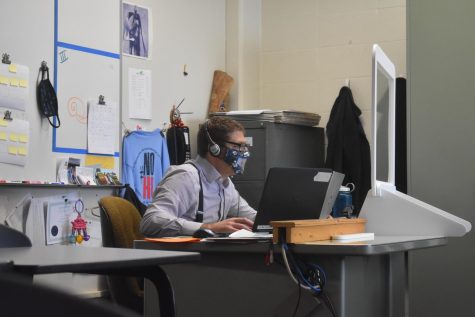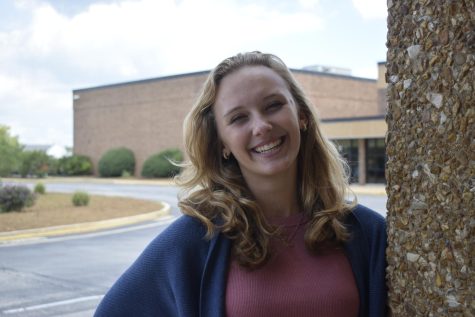тАЬI canтАЩt hear you.тАЭ┬а
тАЬPlease turn on your screen.тАЭ┬а
тАЬMy screen canтАЩt be on while you are presenting or my computer knocks me out of Zoom.тАЭ┬а
тАЬThere is such a lag with what my teacher is saying and what the screen is showing on my Chromebook.тАЭ
These are all realities that teachers and students faced while working to learn a new curriculum in a new format.
тАЬAlmost everything had to be adapted. I did a tutorial on every feature of Zoom. I did a lot of trial and error; I did a lot of asking the kids тАШdoes this work, do you guys like this, do you feel like this is helping you?тАЩ to figure it out,тАЭ French and Spanish teacher Blair Hopkins said.
Coming back in the building, language teachers used masks with a clear strip surrounding their mouths, so students could see how words were pronounced and to better comprehend the content being said.
тАЬThe clear masks were an attempt to allow students to see our mouths as we speak. I feel like it was a good attempt, but was unsuccessful. I have only worn them a few times, but prefer the masks I made for daily wear,тАЭ Spanish teacher Jessica Verweyst said.
Most world language teachers came across complications while trying to teach both in-person and online students simultaneously and providing students with valuable feedback.

тАЬFor me, and I think a lot of teachers would agree, [teaching students in both formats] is the number one biggest challenge. You really canтАЩt give equal attention to the room and equal attention to Zoom. I still think itтАЩs a really big challenge, especially if somebody is struggling on Zoom while I also have people in the roomтАФthatтАЩs really hard. I think as long as we do it this way, as long as we are learning like this, that will be the hardest part,тАЭ Hopkins said.
Educators also experienced difficulties forming relationships with their students, as well as getting the participation needed for a world language class.┬а
тАЬTeaching conversational strategies and providing daily feedback was far harder online than in the traditional classroom experience. It was difficult to form strong relationships with students and I feel like many students struggled with getting daily speaking practice. Since this class focuses on the ability to produce language [by] speaking and writing, I felt like each day was a struggle just to get students to participate,тАЭ Verweyst said.
Hopkins saw that beginning students had more hurdles trying to learn new words and pronunciations than in a normal year.┬а
тАЬWith French 1, it was incredibly difficult for them to have any pronunciation practice. At first, I thought they could unmute and I could hear them repeat before I knew that the entire class cannot unmute at once. With French 1 and Spanish 1 it is really hard to get the basics of speaking the language when there are not that many opportunities for pronunciation practice,тАЭ Hopkins said.
Spanish teacher Francisco Navarro found interactions with his students to brighten his day when he came back to school.
тАЬGetting to know students in-person [has been my greatest reward]. ThatтАЩs been really nice. Being in school and being in-person is much more fun; Zoom is just not fun,тАЭ Navarro said.┬а
Another major change this school year has been the switch from semesters to quarters. Navarro and other teachers were unsatisfied with the 10 week or longer gap that students had between quarters.┬а
тАЬSemesters [are better] because we have more time and I think itтАЩs important to have that content with the teacher in that class for an extended period of time. Despite having less time each day, I think itтАЩs important, especially in a language, to see the students every day, and for the students to be using the language every day,тАЭ Navarro said.┬а
Even though there were obstacles to overcome, Verweyst taught each day with a positive mindset and believes students will persevere through the end of the year.
тАЬBreathe and take each day at a time, today for today. Worrying about tomorrow just wastes valuable time today,тАЭ Verweyst said. тАЬWe are resilient. This year was difficult, but we have all been challenged, and I feel like all Parkway West High teachers rose to the occasion.тАЭ



![Gazing up from the stage, junior Joseph McCurdy who played Peter Pan in the school play, Lost Girl, sits next to senior Juliana Rogers, who plays Wendy Darling, during a theater rehearsal. McCurdyтАЩs passion for theater began when he observed a West High production in middle school. тАЬI've been in the high school theater program since I was a freshman. I've always loved theater, but [what prompted me to join] was [when] I went to see [a performance here] when I was in middle school, and it was super cool,тАЭ McCurdy said.](https://pwestpathfinder.com/wp-content/uploads/2025/11/IMG_6535-1200x798.jpeg)

![Standing tall, stacked in a precise formation, the cheer team strikes a signature pose during halftime on Sept. 12 at the varsity football game. Nearly a month after this performance, the cheer team performed at the Missouri Cheerleading Coaches Association (MCCA) regional competition on Oct. 4, 2025. тАЬWe've all come [to] work together a lot more,тАЭ sophomore Elyssa Philippi said. тАЬWe're a lot closer than we were [earlier in the season] and going to state has made us closer [in] trying to work with each other, learn [new] skills and make our team better.тАЭ](https://pwestpathfinder.com/wp-content/uploads/2025/11/DSC5139-1.jpg)
![Handing out candy to excited trunk-or-treaters, President of the United Nations ChildrenтАЩs Fund club and junior Sara Ashok represents that group. Ashok was eager to participate in this event for multiple reasons. тАЬI really wanted to be a part of the event because I get to help create memories for kids and spend time with my friends, spreading the things [I'm passionate about],тАЭ Ashok said.](https://pwestpathfinder.com/wp-content/uploads/2025/11/DSC_8648-1-1200x800.jpg)

![Smiling in a sea of Longhorns, Fox 2 reporter Ty Hawkins joins junior Darren Young during the morning Oct. 3 pep rally. The last time West was featured in this segment was 2011. тАЬ[I hope people see this and think] if you come to [Parkway] West, you will have the time of your life because there are so many fun activities to do that make it feel like you belong here. I was surprised so many people attended, but it was a lot of fun,тАЭ Young said.](https://pwestpathfinder.com/wp-content/uploads/2025/10/Edited2-1200x798.jpg)
![West High seniors and families listen as a representative of The Scholarship Foundation of St. Louis, Teresa Steinkamp, leads a Free Application for Federal Student Aid (FAFSA) workshop. This session, held in the library, provided guidance on financial aid, scholarships and student loan options. тАЬThis event is very beneficial for any seniors who are applying to or considering applying to colleges after high school [because] the cost of college is on the rise for seniors and parents,тАЭ college and career counselor Chris Lorenz said.](https://pwestpathfinder.com/wp-content/uploads/2025/09/DSC_4478-1200x778.jpg)
![Senior Kamori Berry walks across the field during halftime at the Homecoming football game on Sept. 12. During the pep assembly earlier that day, she was pronounced Homecoming Queen. тАЬI thought it was nice that the crowd [started] cheering right away. I know [my friends] were really excited for me, and my family was happy because typically non-white people don't win,тАЭ Berry said.](https://pwestpathfinder.com/wp-content/uploads/2025/09/DSC7046-Enhanced-NR-1200x798.jpg)




Lisa Haugen • Apr 15, 2021 at 12:12 pm
Wonderful article that truly highlights the hard work and dedication of both students and staff. Bravo!
Amy Kirkou • Apr 14, 2021 at 6:27 pm
Good Job Lydia!
Blair Hopkins • Apr 14, 2021 at 2:49 pm
Thanks for visiting the WL department and telling this story, Lydia (and Ashlyn)!